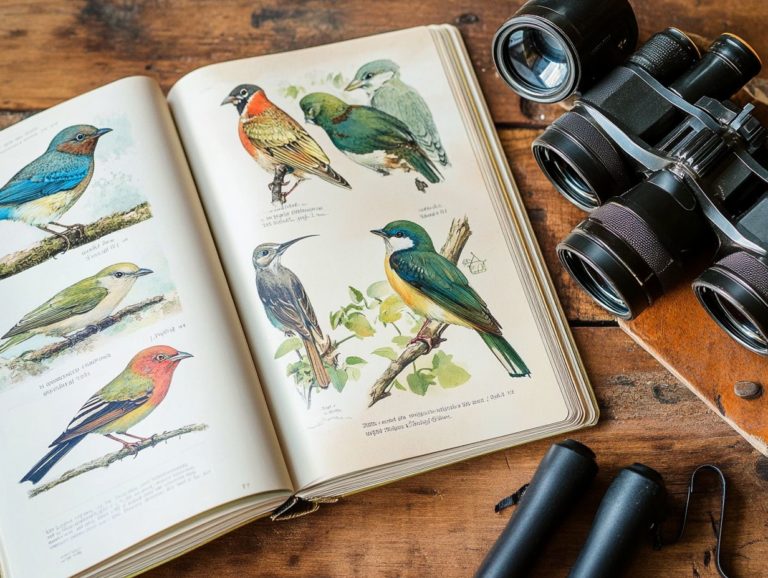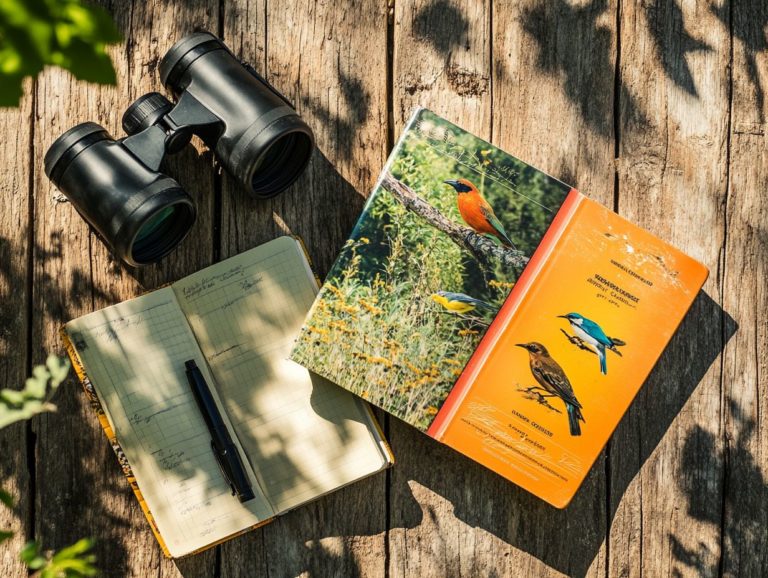Must-Have Field Guides for Eastern U.S. Birds
Explore the vibrant bird life of Eastern North America! Whether you’re a seasoned birdwatcher or just curious, adventure awaits.
You have many field guides to choose from. Identifying local birds is easier than ever!
This article presents ten essential field guides that you should consider, ranging from the meticulously detailed Sibley Guide to the visually captivating Crossley ID Guide.
Alongside these recommendations, you’ll discover what makes field guides indispensable tools for bird identification and how to maximize their potential in the field. Get ready to elevate your birdwatching experience!
Contents
- Key Takeaways:
- 1. The Sibley Field Guide to Birds of Eastern North America
- 2. National Geographic Field Guide to the Birds of Eastern North America
- 3. Peterson Field Guide to Birds of Eastern and Central North America
- 4. Kaufman Field Guide to Birds of North America
- 5. Stokes Field Guide to Birds: Eastern Region
- 6. The Crossley ID Guide: Eastern Birds
- 7. The Audubon Society Field Guide to North American Birds: Eastern Region
- 8. A Birder’s Guide to Eastern Massachusetts
- 9. Birds of the Eastern United States: A Photographic Guide
- 10. The Warbler Guide
- What Are Field Guides and Why Are They Useful?
- Frequently Asked Questions
- What are some must-have field guides for identifying birds in the eastern United States?
- What makes these field guides stand out from others?
- Are there any newer field guides that are worth checking out?
- Do I need to be an experienced birder to use these field guides?
- Are there any digital versions of these field guides available?
- Do these field guides cover all species of birds found in the eastern United States?
Key Takeaways:
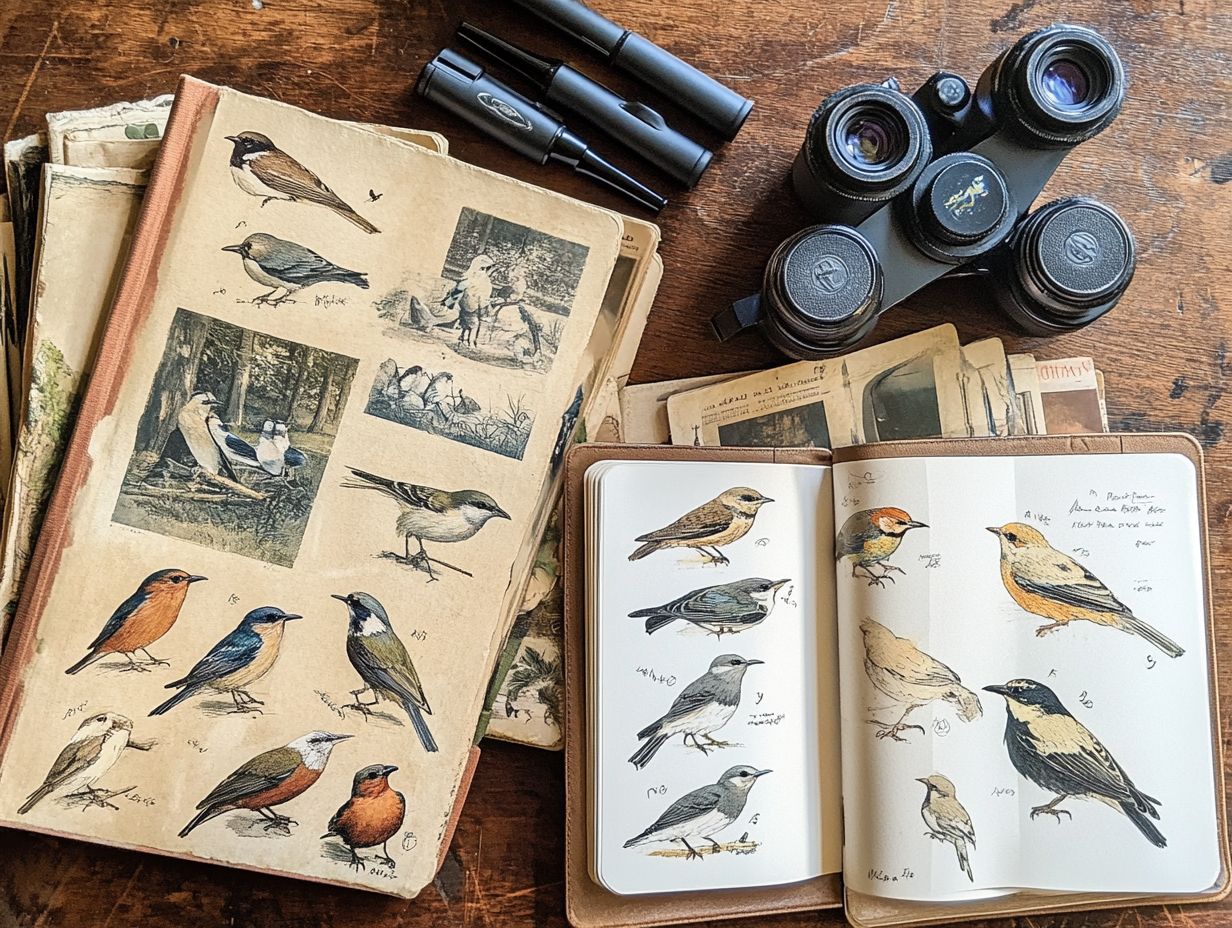
- The Sibley Field Guide is a comprehensive resource for identifying Eastern U.S. birds with detailed illustrations and range maps.
- The National Geographic Field Guide is a visually stunning option with photos and concise information on bird species.
- The Peterson Field Guide covers a wide range of bird species and includes helpful identification tips and birdwatching hotspots.
1. The Sibley Field Guide to Birds of Eastern North America
The Sibley Field Guide to Birds of Eastern North America is an essential resource for any bird enthusiast. It offers comprehensive coverage of over 600 bird species commonly found in this region, showcasing detailed illustrations and extensive accounts that make bird identification a breeze. For those looking to enhance their birding experience, exploring the top field guides for birding in national parks can also be incredibly beneficial.
This guide doesn t just stop at range maps and different feather colors and patterns; it also highlights behavioral traits and bird songs, making it an invaluable tool whether you re just starting out or eager to immerse yourself in the rich bird life of North America.
You ll appreciate its reader-friendly layout, featuring clear and organized sections for a seamless browsing experience. The visual identification tools, like side-by-side comparisons, significantly enhance your learning process.
Unlike other birding guides that can feel dense and overwhelming, this one s accessibility fosters a deeper understanding of local species and their unique habitats.
Within the birdwatching community, it serves not just as a reference manual, but also as a source of inspiration, encouraging you to engage more actively with the natural environment and participate in conservation efforts.
2. National Geographic Field Guide to the Birds of Eastern North America
The National Geographic Field Guide to the Birds of Eastern North America stands as your trusted companion in the world of birdwatching. With its updated features, this guide elevates your bird identification skills through vivid illustrations, detailed accounts, and insightful descriptions of bird songs. For those seeking even more resources, exploring the most comprehensive bird field guides available makes it an essential resource for anyone captivated by eastern birds.
This guide meticulously organizes a wealth of information on various bird species, presenting a user-friendly layout that allows you quick access to vital details. You ll find comprehensive range maps that visually depict where different species can be spotted, making it easier for both casual observers and dedicated enthusiasts to plan their birdwatching adventures.
When comparing it to other popular guides like the Sibley Guide, you’ll discover that this resource offers nuanced insights into specific bird families, such as warblers and sparrows. This ensures that whether you’re new to birdwatching or a seasoned expert, you’ll uncover valuable content tailored to enhance your field experience.
3. Peterson Field Guide to Birds of Eastern and Central North America
The Peterson Field Guide to Birds of Eastern and Central North America is your go-to resource, celebrated for its authoritative take on bird taxonomy. It equips you with essential insights into various species that inhabit these regions, making bird identification a breeze. For more comprehensive resources, check out the most useful field guides for travel birding.
This guide is organized to enhance your understanding of groups of birds and their preferred habitats. It s a valuable companion whether you’re just starting out or have years of birdwatching experience. Each section offers detailed descriptions, habitat preferences, and behavioral nuances, helping you grasp not only the birds themselves but also the ecosystems where they flourish.
The iconic illustrations brilliantly depict the intricate details of plumage and physical characteristics, aiding in accurate field identification. Compared to other birding resources, this guide is user-friendly and provides comprehensive coverage, ensuring an enriching experience as you deepen your appreciation for North America’s diverse avian life.
4. Kaufman Field Guide to Birds of North America
The Kaufman Field Guide to Birds of North America offers a refreshing take on birding with its innovative approach. You ll find high-quality bird illustrations and practical tips that cater to both novice and advanced birders as you explore the rich diversity of North American avifauna.
What truly sets this guide apart is its compact size, making it easy to carry along on hikes or road trips without overwhelming you with excessive information. This resource streamlines the bird identification process with intuitive layouts and modern techniques, encouraging you to engage more deeply with your surroundings.
With cutting-edge birding techniques, such as bird-call recognition and insights on seasonal variations, your birdwatching adventures will elevate into opportunities for a richer interaction with nature. Ultimately, this guide does more than just inform; it inspires a lasting passion for avian exploration.
5. Stokes Field Guide to Birds: Eastern Region
The Stokes Field Guide to Birds: Eastern Region is an invaluable resource for birdwatchers, offering in-depth insights into bird behavior, habitats, and families. It highlights the unique characteristics of eastern birds, enriching your birding experience.
This exceptional guide provides practical tips for identifying local species and features stunning illustrations that truly animate the birds you re observing. With detailed descriptions and captivating photos, it becomes an essential companion during your field trips, enabling you to quickly recognize distinguishing features.
Its organized structure allows you to track seasonal migrations and understand the habitats where various birds thrive, making it easier to spot them in the wild. Whether you’re a novice or a seasoned birder, this guide transforms your outdoor experience into a thrilling adventure, enhancing both your knowledge and appreciation of avian life.
6. The Crossley ID Guide: Eastern Birds
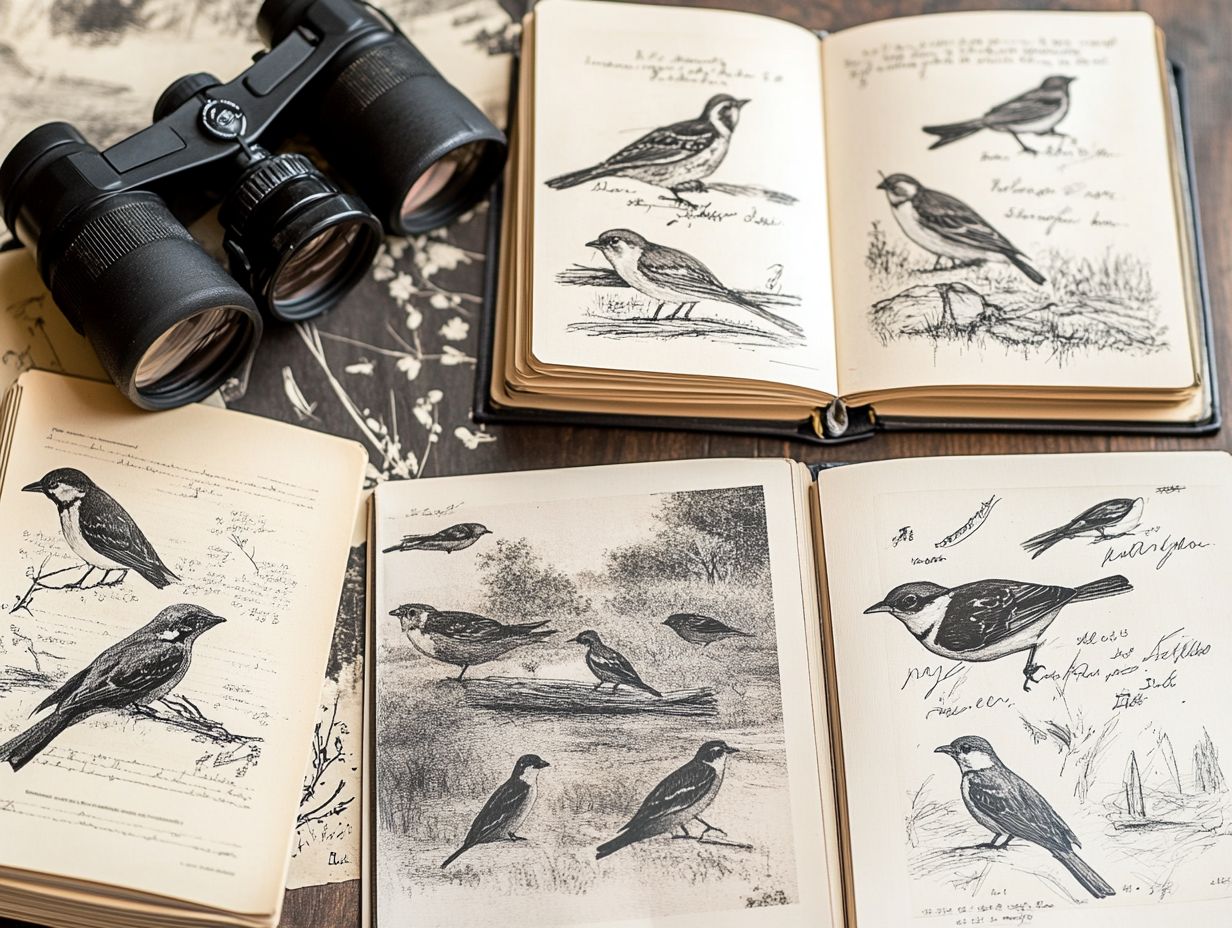
The Crossley ID Guide: Eastern Birds transforms how you identify birds with its captivating visual format. By using real-life photographs and innovative layouts, it enhances your learning experience, helping you connect with eastern birds in their natural habitats.
This guide prioritizes visual identification techniques, making it easier and more intuitive for you to recognize different species. Whether you re a novice or a seasoned enthusiast, you ll find practical applications throughout the guide that enable you to sharpen your skills in diverse settings be it a bustling park or a tranquil forest.
By immersing you in lifelike scenarios and environments, this guide cultivates a deeper understanding of bird behavior and ecology, making it an invaluable resource for anyone eager to explore the avian world.
Don’t wait grab your guide and start spotting birds today!
7. The Audubon Society Field Guide to North American Birds: Eastern Region
The Audubon Society Field Guide to North American Birds: Eastern Region is a timeless classic. It elegantly merges breathtaking bird illustrations with detailed information about bird songs. For those eager to elevate their understanding of eastern avifauna, this guide is an excellent choice, along with the best bird field guides for coastal regions.
Since its inception, this guide has influenced birding practices throughout the region. By documenting the rich tapestry of species found in Eastern North America, it inspires both novice and seasoned birdwatchers to connect more profoundly with their environment and discover the best field guides for birding.
The addition of audio resources allows you to immerse yourself in bird songs, sharpening your identification skills in the field.
As birding has grown more sophisticated, these auditory tools have transformed the experience. You can not only see but also hear the enchanting melodies of nature. This deepens your appreciation for avian life, making each outing a more enriching adventure.
8. A Birder’s Guide to Eastern Massachusetts
A Birder’s Guide to Eastern Massachusetts is a must-read for you, the discerning local birder and enthusiast. It offers tailored insights into the region’s unique avifauna, highlighting local species, prime birding locations, and expert recommendations.
This comprehensive guide explores popular birding hotspots like the Great Meadows National Wildlife Refuge and Plum Island. Each location is brimming with rich habitats that attract a diverse array of birds throughout the seasons.
You ll find local species of interest, such as the striking rose-breasted grosbeak and the elusive merlin. Every birdwatching outing becomes a thrilling adventure, especially for those interested in eastern birds and western birds.
The guide emphasizes community engagement, inviting you to join local clubs and participate in citizen science projects, which are efforts where volunteers help gather data for scientific research.
To enhance your birdwatching experiences, don t miss the thrill of early morning birdwatching for the best sightings! Also, equip yourself with quality binoculars and field guides, including specialized guides for regional bird habitats.
These tools will significantly enhance your understanding and appreciation of the remarkable avifauna that graces this stunning region.
9. Birds of the Eastern United States: A Photographic Guide
“Birds of the Eastern United States: A Photographic Guide” distinguishes itself with its breathtaking collection of bird photography. This guide not only aids you in visual identification but also highlights the diverse bird families that call this vibrant region home, making it one of the popular bird field guides among experienced birders.
The captivating images act as a remarkable educational resource. They enable enthusiasts of all levels to forge a deeper connection with the avian world.
Each photograph showcases unique characteristics like plumage and behavior while encapsulating the essence of each species’ habitat.
This visual element enhances your learning and retention, making it easier for both casual birdwatchers and dedicated ornithologists to identify and appreciate the variety of birds in their midst. Ultimately, this guide transcends traditional printed references, captivating a broader audience with its stunning imagery and reader-friendly guides.
10. The Warbler Guide
The Warbler Guide serves as your go-to identification resource, offering detailed insights into the unique behaviors and plumage variations of warbler species. It’s an essential tool for birders like you, who are captivated by these colorful and elusive birds, whether you are a novice birder or an advanced birder.
With innovative features such as high-quality photographs, bird calls, and comprehensive descriptions, including updated features for mobile apps, this guide enables you to recognize the subtle differences that are crucial for accurate identification. It goes beyond just visuals, looking into the behavioral traits of these birds and providing context that enhances your overall birding experience.
By learning to observe their feeding habits, migratory patterns, and social interactions, you’ll discover how to elevate your birding skills and cultivate a deeper appreciation for these fascinating creatures.
Access to extensive resources is vital for honing your observational skills and ensuring a truly rewarding outdoor experience, particularly with guides like the Sibley Guide and Stokes Field Guide to assist your bird identification.
What Are Field Guides and Why Are They Useful?
Field guides are essential tools for you as a bird watcher or naturalist, expertly crafted to enhance your bird identification skills and improve your understanding of how birds are classified. With a blend of detailed illustrations, visual aids, and comprehensive information about bird species, habitats, and behaviors, these guides enrich your birding experience and deepen your connection with nature.
You’ll find various types of field guides tailored to meet the diverse needs of the birding community. Whether you prefer compact pocket guides that are perfect for on-the-go identification or expansive, visually stunning volumes that serve as authoritative references, there s something for everyone.
These guides cater to both novice birders, who benefit from user-friendly layouts and straightforward descriptions, and seasoned enthusiasts who seek in-depth information along with advanced features like range maps or bird accounts.
As technology advances, so do the capabilities of these guides. You can now find digital apps that offer real-time updates, audio calls, and interactive maps, making birding more engaging and accessible for bird watchers at every level.
The significance of these resources is profound. They not only assist you in identifying avian species but also nurture a shared passion for conservation and a greater appreciation of biodiversity.
What Are the Different Types of Field Guides?
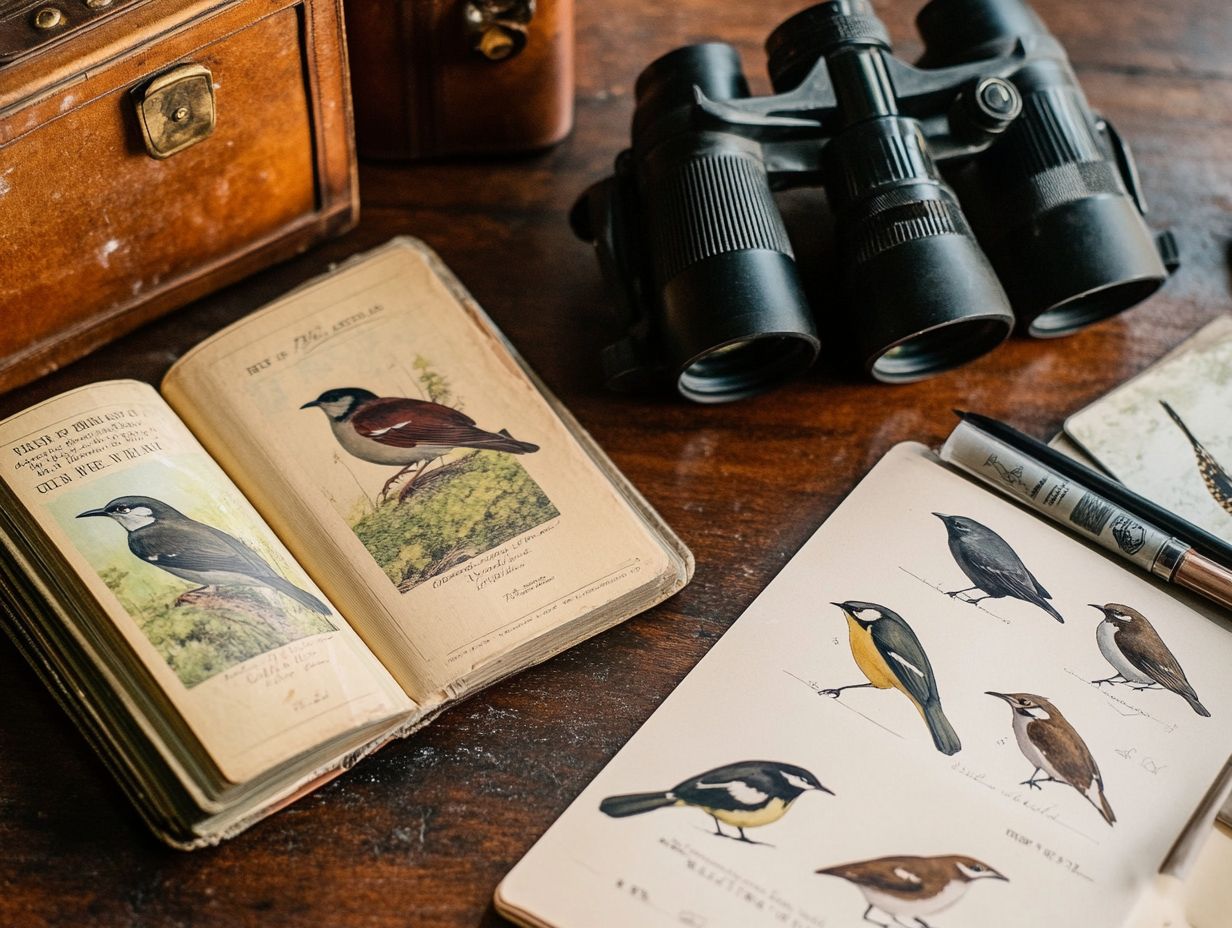
There are different types of field guides, including traditional guides, modern field guides, and specialized guides, each offering unique benefits for identifying birds.
Traditional guides are often hefty tomes filled with rich illustrations and extensive text, catering to those who seek in-depth knowledge and detailed descriptions of species behavior and habitats. In contrast, modern field guides are designed with portability and ease of use in mind, featuring compact sizes and streamlined layouts that make them perfect for your field observations.
Specialized guides focus on specific groups of birds, such as waterfowl or raptors, appealing to those of you with a keen interest in particular avian families. Each type addresses diverse birding needs, ensuring that whether you re a novice or an expert, you ll find a guide that complements your observational habits seamlessly, from traditional guides to modern field guides.
Explore these guides today and deepen your birding adventures!
How Can a Field Guide Help with Bird Identification?
A well-structured field guide is an invaluable tool for bird identification! It offers clear visuals and detailed accounts of various species, including bird illustrations that capture the essence of bird families.
With these resources at your fingertips, you can swiftly recognize birds using effective visual identification techniques and precise descriptions. To truly harness the power of these guides, grasp the specific habitats where different birds flourish.
By aligning the information in your guides with the environmental context like vegetation, geographical location, and time of year you can refine your search strategy. This dramatically enhances your chances of successful identification while addressing potential identification issues.
These guides often tackle commonly confused species, highlighting subtle differences in plumage, vocalizations, and behaviors. They provide insights into behavioral traits that can aid in identification.
Presenting contextual information enables you to navigate potential challenges with ease, transforming overwhelming options into clear choices.
What Are the Key Features to Look for in a Field Guide?
When selecting a field guide, prioritize key features like clear illustrations, accurate range maps, and updated information. Look for guide innovations that enhance your bird identification skills and support effective birding techniques.
Strike a balance between user-friendliness and comprehensive coverage! The ideal guide should appeal to both novice birdwatchers seeking approachable content and seasoned enthusiasts craving detailed insights.
Understanding behavioral traits such as migration patterns and bird behavior is significant for grasping bird species and elevating your overall birdwatching experience.
Incorporating local species information ensures you access relevant data specific to your region. This enhances your understanding of American birdlife and its biodiversity. This blend of accessibility and depth allows you to engage more fully with your surroundings, fostering a deeper appreciation for the diverse avifauna you may encounter.
What Are Some Tips for Using a Field Guide in the Field?
Using a field guide effectively in the field involves a few essential tips. Start by familiarizing yourself with the guide’s structure. Hone in on identifying bird behavior while employing visual identification techniques to elevate your birding experiences.
Engage with local birding opportunities to connect with seasoned birdwatchers eager to share invaluable insights, particularly within the birding community. Approach birdwatching with patience for the best results! The art of birdwatching often requires prolonged waiting and keen observation.
By quietly observing your surroundings and the habits of various species, you’ll cultivate a deeper appreciation for the intricacies of bird life. Participating in guided bird walks or joining local birding groups can offer a wealth of information while fostering a sense of community among fellow enthusiasts.
Grab your field guide and start exploring today!
How Can a Field Guide Help with Birding Trips and Travel?
Field guides are essential companions for your birding trips, offering helpful information about local habitats, the variety of bird species, and practical tips for bird photography. They include references to Audubon paintings and expert guide reviews, elevating your overall birding experience.
These guides help you identify prime birdwatching locations and highlight seasonal changes in bird populations. This enriches your birding adventures in North America. By consulting a well-reviewed field guide tailored to your destination, you can uncover hidden gems and popular sites alike.
Consider guides focused on regions like the wetlands of Florida or the highlands of Peru! They provide detailed information about the best times to visit and which species you re likely to encounter in different seasons.
With such expertise at your fingertips, each birding outing becomes not just productive but also deeply fulfilling. This ultimately enhances your connection with nature and the birding community.
Frequently Asked Questions
What are some must-have field guides for identifying birds in the eastern United States?
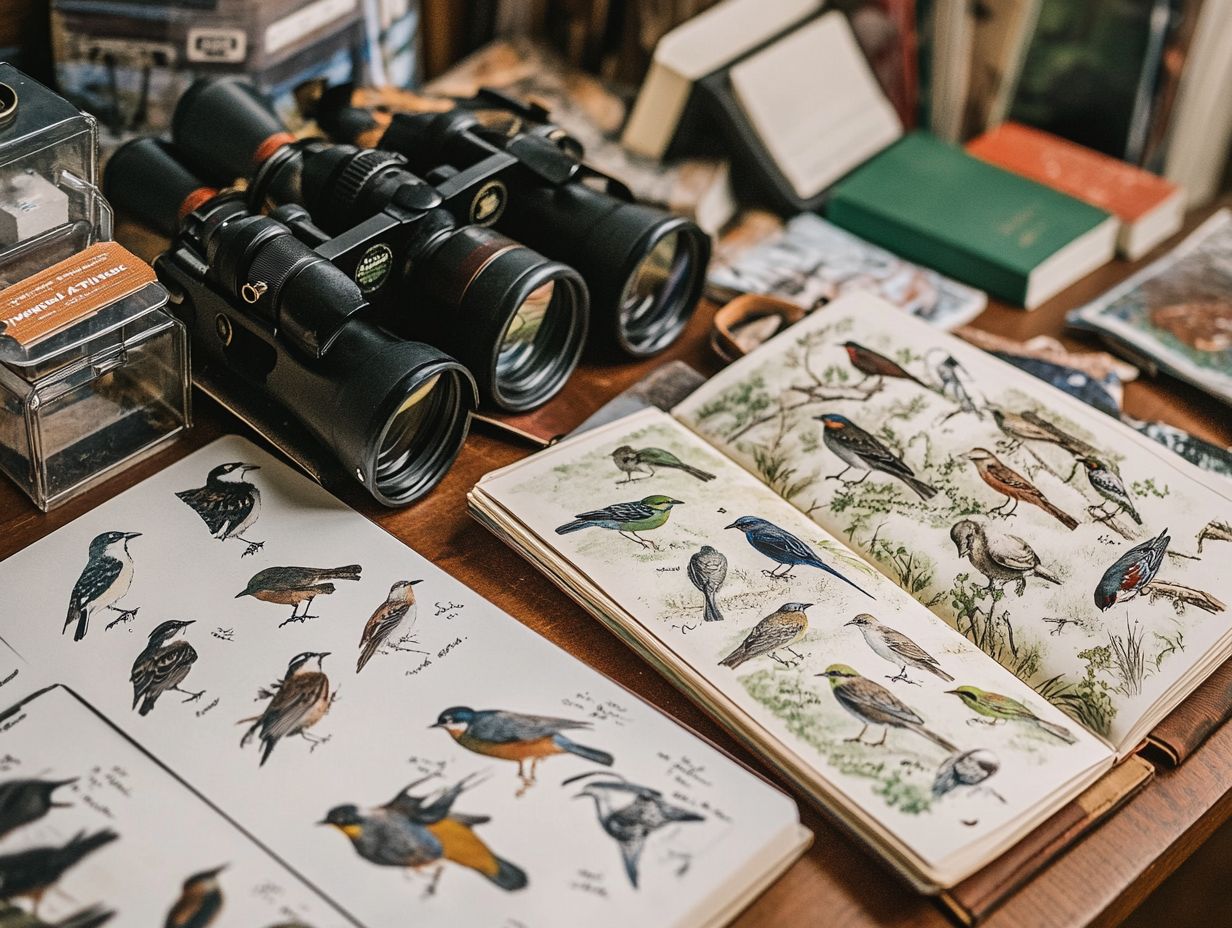
Popular options include The Sibley Field Guide to Birds of Eastern North America, National Geographic Field Guide to the Birds of North America, and top field guides for coastal birding adventures like A Field Guide to Eastern Birds by Roger Tory Peterson, a classic for bird identification.
What makes these field guides stand out from others?
These field guides provide comprehensive coverage of bird species found in the eastern United States. They include visual identification techniques, detailed illustrations, and information on bird behavior and habitat, making them essential for enthusiasts looking for the top field guides for North American birds.
Are there any newer field guides that are worth checking out?
Yes! The Kaufman Field Guide to Birds of North America and Stokes Field Guide to Birds: Eastern Region are popular newer options for identifying eastern U.S. birds. For even more resources, check out the regional bird field guides you need to own, which feature updated content and innovations.
Do I need to be an experienced birder to use these field guides?
No! These field guides are user-friendly and accessible for both beginners and advanced birders, providing helpful tips and techniques for bird identification.
Are there any digital versions of these field guides available?
Yes! Many of these field guides have digital versions accessible through mobile apps or e-readers, making them ideal for birding adventures.
Do these field guides cover all species of birds found in the eastern United States?
While these guides cover a wide range of bird species, don t forget that new species are constantly being discovered. Some may not be included in these guides, leading to identification challenges. Supplementing with additional resources is always helpful.




